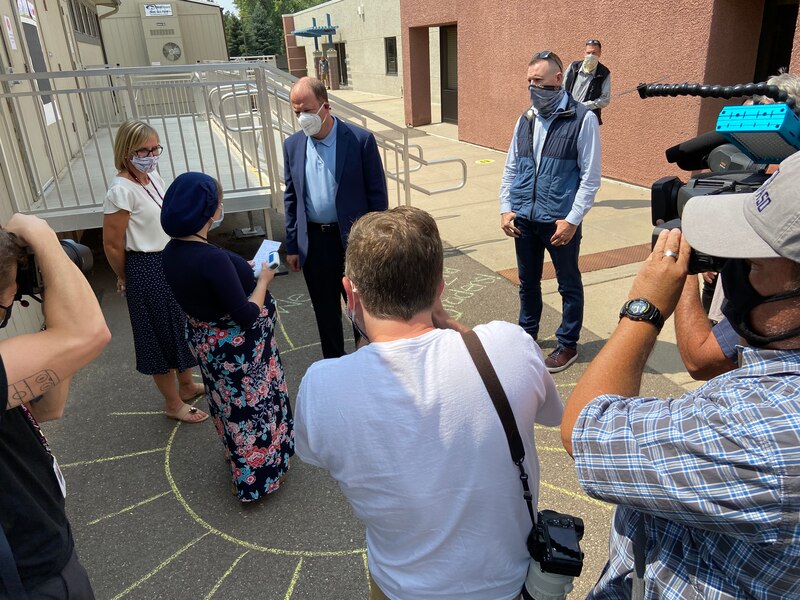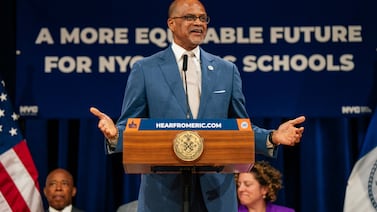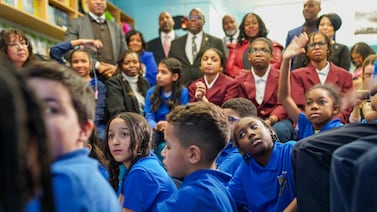Outside a suburban Denver elementary school, Colorado Gov. Jared Polis bent his head for a temperature check before getting the all-clear to head inside and meet a small group of masked second-graders who were back in school for the first time since March.
He was at Village East Community Elementary School, part of the Cherry Creek School District, on Thursday to underscore a message he’s been pushing for months: Children need to be in school, and it’s safe for them to be there, at least as safe as anything is during a pandemic.
“There’s people that work in grocery stores every day, there’re still cops out in the street, as governor I still have to do public events, but we’re doing it in a different way,” he said.
“And this is what we’re learning to do in our schools.”
Despite Polis’s encouragement, school districts that serve almost half of Colorado’s 913,000 K-12 students have chosen to keep students home, some for a few weeks, others for the entire first quarter. Even in school districts holding classes, tens of thousands of families have opted for remote learning as the coronavirus threat persists.
Colorado’s experience of school reopening has been a microcosm of the nation’s, marked by uncertainty and disparities. Students are facing wildly different educational experiences based on where they live. It’s not clear when students learning at home might get back in the classroom or whether students now in the classroom will stay there.
District leaders received inconsistent or vague guidance from state and local officials on how to open and no clear metrics for determining when and whether it’s safe to do so. In Colorado’s long tradition of local control, districts were left to weigh conflicting advice and political pressures, then craft reopening plans they hoped would keep students and teachers relatively safe and meet parent and community needs.
When COVID cases rose in the summer and public health officials issued dire warnings, school officials faced a kind of snow day decision from hell. They were looking at a complex forecast that stretched over weeks, not days — with lives potentially hanging in the balance.
An optimistic start
When Colorado schools shuttered in mid-March as part of a broader effort to slow the coronavirus, parents rearranged their lives and educators scrambled to set up emergency online learning. Colorado’s shutdown worked. By May, new COVID cases were in steady decline.
But everyone from parents to pediatricians were dismayed by the cost that children paid for this success in lost learning, social isolation, and hunger. In public statements and on calls with school leaders, Polis said school would look different in the fall — staggered passing periods, no schoolwide assemblies — but children should be back in classrooms.
Public health guidance still put strict caps on gatherings. To keep class sizes small, some districts announced plans for hybrid schedules that would have students in school just a few days a week. These proposals sparked a strong backlash. How on earth were parents, including many public school teachers, supposed to work with children in school just a few days a week?
In an email to other metro area superintendents on June 1, Jeffco Superintendent Jason Glass raised a concern: More than half of parents in a district survey selected full-time in-person as their preference, despite a warning it might not align with public health recommendations.
“This is going to be a significant conflict with proposed A/B alternating schedule days or weeks proposals that we (and many other districts) are contemplating,” he wrote. And he wondered if the governor or public health authorities might provide clearer directives.
“In absence of that clarity, there will be tremendous desire/pressure to move toward a model with little or no social distancing included as a virus mitigation component,” Glass continued. “It may create a ‘race to the bottom’ once some district or school chooses to reopen school and have all their students in classes and buildings. The argument will be ‘see, they did it … why don’t you?’”
Polis did provide clarity, of a sort.
In two calls, one with charter leaders and the other with district superintendents, the governor told school leaders not to worry about the 10-person cap on class sizes in official state guidance issued just a few days earlier. Instead, he encouraged school leaders to plan for relatively normal class sizes and rely on “cohorts” — groups of students and teachers who interacted only with each other — to limit the spread of the coronavirus within schools.
Some superintendents welcomed the news.
“This set the stage for a realistic return that is so good and needed for children,” Superintendent Lisa Yates of the Buena Vista School District in the Arkansas River Valley wrote in an email to Colorado Education Commissioner Katy Anthes after the call. Yates has called for treating schools as “essential” and allowing local communities to set their own conditions for re-opening.
Others expressed frustration at the shifting message. Superintendent Peter Hilts of the Falcon 49 district in Colorado Springs said in an email to Anthes that he’d spent weeks planning for one scenario, only to shift gears. Colorado’s open enrollment system would create pressure on districts to offer full-time classes if their neighbors did.
“I predict any district that opens up with less than a full schedule will drain students as parents look for full coverage so they can return to full work schedules,” Hilts wrote to Anthes in June.
Within days of the governor telling school leaders larger class sizes would be possible, the Mapleton and Westminster districts serving north Denver suburban communities announced they would hold classes five days a week. Districts that previously announced hybrid plans, including Denver and Jeffco, scrapped them, announcing plans for full-time, in-person learning, though parents could still choose an online option.
As Denver Superintendent Susana Cordova wrapped up a press conference in late June announcing the district would bring students back to school full time, she stepped aside to take a phone call.
“That was the governor,” she said a few minutes later. “He’s happy.”
Looking back, Roaring Fork Superintendent Rob Stein said he’s not sure if Polis’ push for full-time school influenced him or simply reflected back his own mood.
“We were all optimistic at that time,” he said. “We’d been disciplined about staying at home and the incidence was going down.
“But then over time it became clear we were going in the wrong direction.”
Colorado opened up — and COVID rebounded
Through the first half of June, new COVID cases and hospitalizations continued to fall. Polis took steps to further open the economy, culminating in an executive order that allowed bars and nightclubs to open at reduced capacity on June 19.
Polis took these steps even as he pointed to Texas and Arizona as cautionary examples. In reality, new cases had already started to increase, but it would not be apparent for a few weeks. Polis reversed course and closed bars again on June 30.
Through July, every COVID indicator in Colorado moved in the wrong direction. Case numbers, hospitalizations, and test positivity — the percent of people tested who get a positive result — all increased. Public health officials sounded the alarm: If Coloradans didn’t change their behavior quickly, the state’s intensive care units would be overwhelmed by September.
On July 16, Polis issued a statewide mask order, a step he had resisted for months.
“What is at stake is our children’s ability to head back to the classroom, where their education is better served,” Jill Hunsaker Ryan, executive director of the Colorado Department of Public Health and Environment said in late July. “We’re at a critical juncture in allowing that to happen.”
Rising cases, testing delays, and scared teachers forced districts to rethink in-person learning
By the time Polis issued his mask order, plans for in-person school were already crumbling in some districts. Denver Public Schools was the first to make the call, just three weeks after announcing its intent to bring students back full time. On July 17, Cordova said all students would remain home until at least after Labor Day. She later delayed the start of in-person school until at least Oct. 16 for most students.
Following state guidance, Denver had built its reopening plans around keeping cohorts separated. But the district’s schedules, designed to meet an array of educational needs, created cohorts of up to 60 people at the elementary level and 120 at the secondary level.
Local public health officials who had urged a return to school balked at the large number of students and teachers who would be interacting every day, especially in a climate where cases were rising. Nor could they give the district a lower number it should aim for.
“It would definitely be easier to make decisions if we had stable conditions and guidance,” Cordova said. “It’s the reality that as the infection rates change, we change along with them.”
President Donald Trump and Education Secretary Betsy DeVos threatened to withhold funding from schools that did not open, further politicizing an already challenging decision. In Colorado, the state teachers union called for a remote start to the school year.
At the same time, a short-lived consensus that children do not contribute to the spread of COVID was coming apart. A study out of South Korea found that children older than 10 spread the virus as easily as adults, and some states saw outbreaks at childcare centers and summer camps.
Teachers became increasingly fearful, especially as they compared best practices to the realities of their classrooms. Public health guidance talked about good ventilation, while some classrooms didn’t have windows that opened — or any windows at all. Guidance talked about separation between cohorts, but students come and go from classrooms all day for specialized services.
Many parents still favored a return to in-person school, but many others told their districts they preferred to stay remote. People of color, many of whom work in front-line jobs, have been hit harder by the disease. These parents were more likely than white parents to say they would keep their children home.
In announcing his district’s remote start, St. Vrain Superintendent Don Haddad cited not only rising cases in Boulder County but widespread anxiety among teachers and parents that would not be conducive to learning.
When the Poudre and Thompson districts announced they would start remotely, Larimer County’s public health director said long delays for testing results — a national and state level problem — required that districts reconsider their plans.
Schools making public health decisions
On July 20, the Colorado Department of Education and the Colorado Department of Public
Health and Environment issued new guidance for schools that encouraged normal class sizes at the elementary level. In a major shift from previous guidance, it said that 3 feet of distance, not 6 feet, provided adequate protection when coupled with mask-wearing, hand-washing, and good ventilation. The new guidance again emphasized cohorts but did not place any cap on how many people could be together.
The guidance was different for secondary students, though: They should remain 6 feet apart, if possible. Some districts shifted to a hybrid model for high school to reduce class sizes.
Some district leaders found elements of the guidance helpful — for example, emphasizing cohorts or thinking differently about younger and older students. Some chafed under the restrictions imposed by guidance, while others sought clearer direction.
The guidance also told districts to stay remote “if best for your community.”
“A few of the pieces left it so open,” said Scott Siegfried, superintendent of the Cherry Creek district. “I think that’s where some districts are struggling.”
In a call about the new guidance, superintendents peppered state education and public health officials with questions. What did it mean to work with local authorities in counties where those officials openly defied state orders? Was it better to open classroom doors for ventilation or keep them shut against intruders? And what about buses?
Recommendations to limit how many students ride the bus have bedeviled large urban districts and rural ones alike. Districts lack funds to buy more buses, and even before COVID, there was a shortage of bus drivers.
“If we can’t get the kids to school, there will be no school in person,” Terry Kimber, chief financial officer of the Widefield district in southern El Paso County, wrote in the chat of a Zoom call on the new guidance. “Flexibility on busing students is needed. We need a final guidance ASAP.”
Many states have set thresholds tied to test positivity or case rates for when it’s safe to open schools. Colorado has not yet done so, nor have many local public health agencies.
In Roaring Fork, Stein worked with three different counties to develop metrics and then waited until late July to make the call to start online. He considered that the last possible moment to make a decision and still plan for a late August start.
“We do not want to be in the position of making public health decisions,” he said. “The more we can get clarity from them about defining risk, the more clarity we can have.”
The Cherry Creek and Douglas County school districts developed their own thresholds to bring students back. But in Aurora, school board members worried that public health guidance was being shaped by political and economic pressures. They opted for a remote start.
In many cases, districts in the same county have made different decisions after looking at the same public health data. Pueblo D60, which serves students in the southern Colorado mill city, is bringing students back to class, while Pueblo D70, which serves the surrounding county, is keeping all but the highest-needs students online until at least mid-September.
When asked whether state guidance had been helpful, Pueblo D70 board President Debbie Houghton laughed.
“It would have been a lot easier if we knew what we had to do,” she said. “But they don’t know either how to move forward.”
Colorado’s COVID data improves, but school remains uncertain
The health alarm raised in July and the policy changes that followed seem to have had an impact. Cases, hospitalizations, and test positivity rates have declined, with test positivity below 3% statewide as many students return to the classroom. Public health officials say cases could rise again with the start of school, so a low baseline is important.

Seeing positive trends, Cherry Creek’s Siegfried decided to reopen full-time for elementary students and with a hybrid model for older students. The district requires masks and checks symptoms daily. Students are separated in small cohorts, made easier by the 20% of students who opted for online learning. COVID testing identified five asymptomatic staff members before they went back to work.
At Village East, the school Polis visited this week, Principal Mia Robinson said she was proud of her staff and her students for a great first week.
“We can show other schools that this is possible,” she said. “Anybody who thought we couldn’t do it, yes, we can and we are.”
Asked why so many students are out of school, Polis said some districts are “just not as far along” in their planning. He has urged parents to take advantage of school choice if they don’t like what their own district is offering.
But school districts have changed their plans so rapidly in the final weeks that even the state education department is struggling to keep track. Parents, in turn, have delayed their own decisions, making it harder for school districts to plan. And even into August, the trends in El Paso County — more than 100 cases per 100,000 residents and test positivity above 5% — caused several school districts there, including Falcon 49, to announce a remote start after planning all summer for full-time school.
“Many of our districts are taking baby steps to get back into school,” said Anthes, the education commissioner. “We have to realize not every district has the exact same buildings, the same number of teachers, the exact same square footage of a classroom. All of these things mean we have to allow some local decision-making.”
In Roaring Fork, Stein said he believes in local control but the pandemic calls for a different approach.
“A crisis like this demands more centralization,” he said.
State officials are working on clearer metrics for when it is safe for school to be in session, but at the August State Board of Education meeting, Anthes acknowledged guidance was “not exactly imminent.”
Meanwhile, COVID has already forced students in a half-dozen districts to online learning just as school was beginning. In Fort Lupton in Weld County, a student in one high school cohort tested positive, followed by one in the second cohort, closing the entire high school for two weeks. Each cohort had more than 200 students. If the cohorts had been smaller, the school might have stayed open, but state guidelines have no cap.
“Districts have to learn and see what happens when you have a big cohort,” Anthes said. “That means you have to shut everything down. We would hope that maybe as they come back they could make those cohorts smaller.”
Many districts starting online are also straining to get ready. Some, including Denver, don’t have enough laptops for all students. The state online school, used by many smaller districts, is scrambling to hire enough teachers to meet demand from a last-minute surge in requests.
Asked if Polis could have done more to support the return to school, spokesman Conor Cahill pointed to the existing state guidance, as well as the governor’s promise to provide every teacher one medical-grade mask each week. The state currently has enough supply to last 10 weeks.
“The governor’s priority has always been the health, safety, and well-being of Coloradans,” he said, “and that includes ensuring that our schoolchildren are able to learn, whether the school is remote or in-person.”







